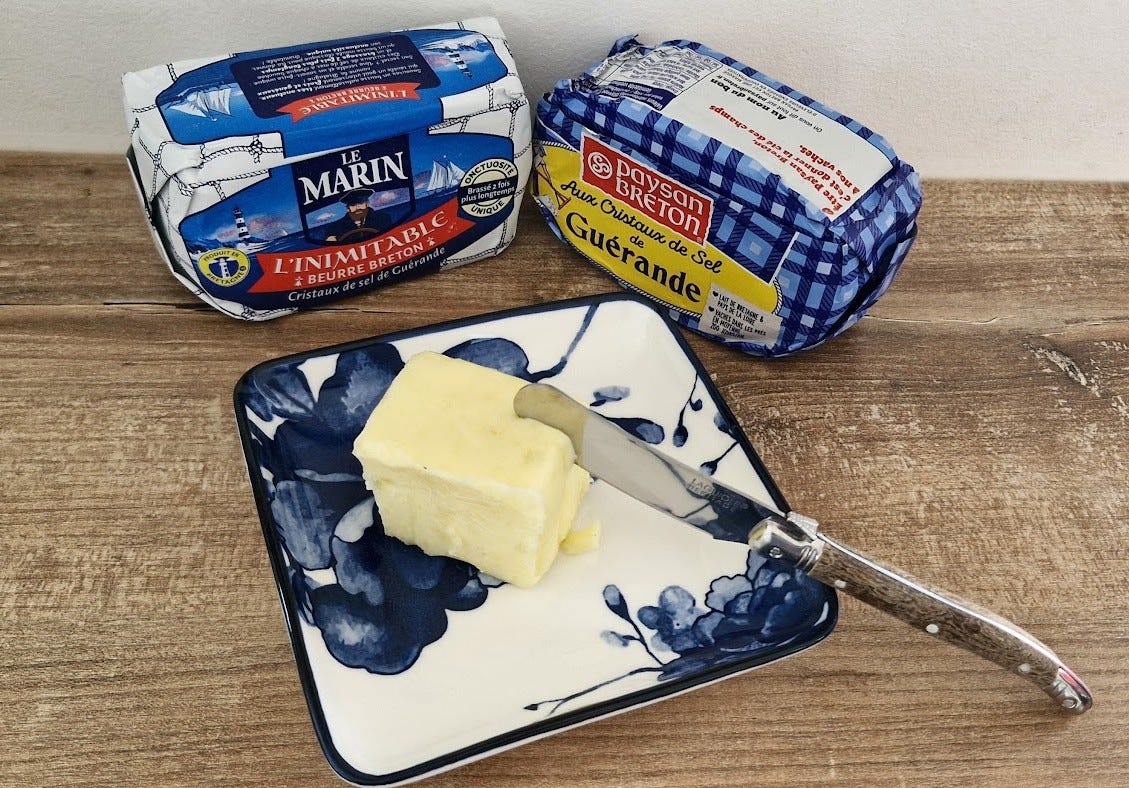The first time I tasted the local spread, the sun broke through the clouds, the angels sang Hosanna and tears filled my eyes. I collapsed to my knees with the realization I had wasted — foolishly wasted — the first 65 years of my life.
Sorry, Land O’Lakes, I now see my pre-French life was empty and meaningless without Breton butter.
The sweet flavor, the creamy texture and the salty salt salt are a holy freaking trinity for my tastebuds, a veritable salvation from a lifetime of wandering in the wax paper-wrapped wilderness of American toast spackle.
Clearly my affection for Brittany’s butter is out of proportion. But that’s only because the supermarket variety I’d been raised on back in Philly was so, um, unmemorable. I mean, really, what is there to be said about Breakstones or the store brand from Shoprite? It was just something to spread on my morning bagel to help grease the gullet. My palate was so undeveloped, I honestly could say, “I Can’t Believe It’s Not Butter!”
But the veil has been lifted.
In the morning, I carefully unwrap the blue-and-white foil around a square of Payson Breton, each yellow slab to be slathered and savored. Spread on a crusty baguette, melted into a warm croissant, perched atop a sugared crepe, Breton butter – with its crystals of salt harvested from the marshes of Guérande — is capable of transforming even the most humble sustenance into haute cuisine.
(Before I go on, a quick note to Irish butter lovers: Don’t get bent out of shape. I like Kerrygold, too. But it says something that the only place you can buy it around here is one of those Irish souvenir shops that sell lemon curd and shamrock boxer shorts.)
So, why is it so much better than the butter I was raised on? I had to find out.
Like all great cuisine, it’s an expression of natural ingredients and painstaking craftsmanship.
Of course, it all begins with les vaches laitières (dairy cows). You see them lazily chowing down on grassy meadows wherever you go on our lush peninsula. Other than their colors – reddish brown or black and white — I really can’t tell the difference from one to the next. (They’re all named Elsie, right?) Though Brittany has its share of everyday Holsteins, I’m told the locals are particularly proud of lesser-known French-bred varieties: Montbéliarde, Simmental and Normande. Another variety, the cherished Bretonne Pie Noir, is smaller than most dairy cows and produces less milk. But its higher fat content makes it a favorite among butter artisans.
What cows eat seems to make a difference, too. In Brittany, they mainly gulp down grass instead of grain, a more natural feeding choice that produces a richer flavor in butter and — healthy diet alert! — omega-3 fatty acids.
I won’t get too deep into the buttermaking weeds, but there are a few other important differences that make French butter so much tastier than the stuff I grew up on:
American butter is made with fresh, sweet cream, which sounds nice but it’s terribly one-dimensional when it comes to flavor. French buttercream is cultured overnight, or fermented like yogurt, a step that broadens its flavor profile. It’s like sending your boring suburban kid to Paris for one of those study-abroad summers and he comes back home quoting Rimbaud.
French butter has a higher fat content than America’s (82% to 80%) and less water. And, honestly, can we finally admit that fat is good?
The small butter producers of Brittany say they churn with paddles instead of industrial centrifuges, a painstaking step that produces a creamier texture. Sounds legit to me.
Finally, there’s the salty salt salt.
Now, you can find plenty of salted butter in America. It’s usually hidden behind the Crisco. But that’s not salt you’re tasting. It’s the sad tears of Jacques Pépin, who cries for your lost soul.
Salted butter in Brittany is a pagan experience, unrefined and spiritual. The crystals aren’t just sprinkled pixie dust; they’re rooted in the depths of the butter, breaking the surface like those ancient stone menhirs that tower across the countryside. When you crunch on them, you’d be forgiven if you thought you’d just lost the crown on one of your molars.
You can buy demi-sel if you like, but whatever you do, don’t ask for beurre doux. They’ll think you’re Parisian, you poseur.
How salted butter became such a cherished icon in these parts, I’m not altogether clear. Something about a tax law from seven centuries ago. (They have long memories here.) Whatever, it’s a point of pride, promoted by regional tourism boards and reflected by the huge butter displays in supermarket dairy aisles. Local restaurants wouldn’t think of serving hearty baguettes without individually wrapped slices of beurre aux cristaux, while hotels order their own custom hand-shaped and molded patties and cones.
Le Beurre Bordier from Saint-Malo, which produces a wide variety of flavored butter (garlic, smoked, truffle, seaweed), is probably the most famous… and expensive. It’ll run you nearly 5 euros for 125 grams. A lot of gourmands (including the New York Times) say Normandy’s Isigny Sainte-Mere is even better, for half the price. I can’t argue with that pick, but we support brands from Brittany. So it’s usually either Paysan Breton or Grand Fermage (my favorite) that’s stocked in our fridge, at about €1.75.
Melted into a steaming baked sweet potato, it’s a meal upon itself.
Which is the best part about Breton butter. It’s not only transformative, it’s an affordable everyday luxury.







I wish we could send our butter for a semester abroad in Brittany. 😋
What a great piece! Thank you! I'm bretonne myself, and also have a never-ending love story with le beurre salé breton, but didn't know what made the difference, so it was very enlightening! Merci !